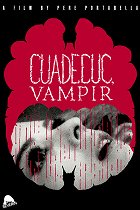Opisy(1)
Made in Spain while General Franco was still in power and shown clandestinely, Pere Portabella's extraordinary Vampir Cuadecuc ostensibly follows the filming of Jesús Franco's shocker El conde Dracula starring Christopher Lee, Herbert Lom and the exquisite Soledad Miranda. This experimental 'making of' documentary and investigation into the myth of the vampire, becomes a powerful political metaphor for bloodthirsty fascism epitomised by Franco and tyrants like him, a witty allegory with Dracula as the dictator whose demise is certain. Dispensing almost entirely with dialogue, Portabella utilises an abstract, fabulously idiosyncratic soundscape created by renowned Catalan artist and musician Carles Santos. The effect is surreal and wondrous to behold. (Second Run)
(więcej)Recenzje (1)
Unusual self-reflexive techniques of the Barcelona film school in the service of vampire horror. High-contrast black-and-white 16-millimetre shots from the filming of Jesús Franco’s colour Count Dracula is accompanied by disturbingly rash and inappropriate music by Carlos Santos instead of the original soundtrack. The result is a “rewrite” of the original work at the moment of its inception. The timely revealing of the utilised tricks demolishes the illusion and turns the horror movie into a dark comedy. The film is not allowed to scare us, as we see how it intends to deceive us. The context of the origin of avant-garde subversiveness adds a political dimension – Dracula here represents the seemingly indestructible, repressive Francoist regime, which, however, appealed to Spaniards in its completed, more terrifying form. Portabella thus casts doubt on two forms of power: the power of film over the viewer and the power of Franco over the Spanish people. Both the medium of film and the dictator must create illusions to draw attention away from the internal mechanisms. Vampir rejects both types of deception. Together with the director’s Catalan origins and the fact that Portabella was involved in the production of the banned Viridiana, this was one of the reasons that for a long time only a lucky few were able to see the film in Spain (and why the filmmaker was unable to personally present it at the Museum of Modern Art in New York in 1972). 70%
()
